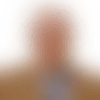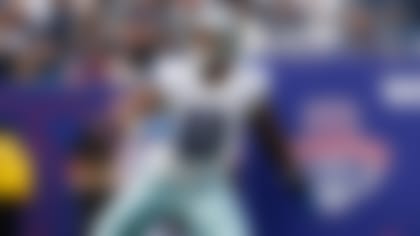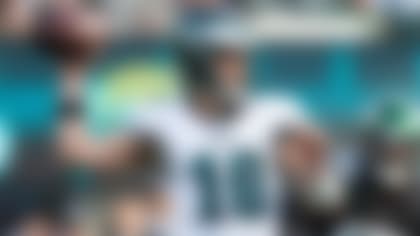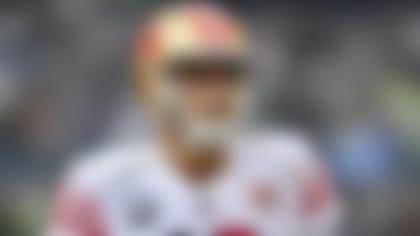Every draft includes its share of hits and misses. But the 2012 NFL Draft looks exceptionally rough in retrospect, with a number of first-round washouts, including Trent Richardson, Justin Blackmon, Michael Floyd and Quinton Coples. Eight years later, we know how the careers that began in 2012 have ended up playing out. Let's travel back in time for a moment and use that knowledge to re-do the first round of this draft.
NOTE: For the sake of simplicity, I used the final draft order, reflecting where teams picked after all the wheeling and dealing that normally accompanies the draft was completed, regardless of whether a pick was traded weeks or minutes before the selection was entered. To make each pick, I weighed both initial talent and the proven production of the players in question.
Russell Wilson might seem like the obvious choice here, but this isn't just a straight ranking of the best players who started their careers in 2012. If we're giving teams the imaginary power to undo the mistakes they made on a few days in April eight years ago, why not also give them the ability to avoid the
*other* team-building missteps they committed in the interim? The problem with Luck's career trajectory, which ended with his
surprise retirement last year, was not Luck -- it was the
Colts' inability to build an offensive line that could keep Luck healthy enough to thrive long-term. Talent-wise, I'd still have to take him first overall. And in our reinvented timeline, we'll say Indy will go on to assemble a roster that fully maximizes that talent.
</content:power-ranking>
**Wilson was actually drafted:** by the
Seahawks in Round 3 (No. 75 overall).
Wilson became the QB Washington was hoping RGIII would have been -- and then some. It's not an understatement to say the six-time Pro Bowler would have changed the course of franchise history.
**Foles was actually drafted:** by the
Eagles in Round 3 (No. 88).
Part of Pat Shurmur's undoing as Browns coach was his inability to find an answer at QB, with neither Colt McCoy nor 2012 first-rounder Brandon Weeden (picked 22nd overall) coming through. One year after this season, Foles and Shurmur (he became Chip Kelly's offensive coordinator after being fired by Cleveland) would link up in Philadelphia and produce the best regular-season marks of Foles' career to date: a 27:2 TD-to-INT ratio, 119.2 passer rating and 9.1 yards-per-throw average, with an 8-2 record. It's true that other, more accomplished QBs are still on our hypothetical re-draft board at this point, but imagine Shurmur and Foles making that kind of magic on the shores of Lake Erie.
**Reiff was actually drafted:** by the
Lions in Round 1 (No. 23).
**Hilton was actually drafted:** by the
Colts in Round 3 (No. 92).
Over the past eight years, the Jags have had an up-close-and-personal view of what they missed when they passed on Hilton in Round 3 in favor of punter Bryan Anger, with Hilton racking up four Pro Bowl nods and the fifth-most receiving yards (8,598) in the NFL in that span as a member of the AFC South rival Colts. Blackmon's career, unfortunately, was leveled by substance-abuse issues.
**Gilmore was actually drafted:** by the
Bills in Round 1 (No. 10).
Gilmore became the shutdown corner the Cowboys hoped they were getting in Claiborne, who never really caught on in Dallas. Only three players ( Richard Sherman, Marcus Peters and Reggie Nelson) have more picks over the past eight seasons than Gilmore (24), who was a centerpiece of the Patriots' top-ranked defense in 2019, earning Pro Bowl and first-team All-Pro honors for the second consecutive season while also taking home the Defensive Player of the Year award.
**Cox was actually drafted:** by the
Eagles in Round 1 (No. 12).
Defensive tackle Gerald McCoy made the Pro Bowl six times in his nine Bucs seasons, but can you imagine how much more he would have flourished if he'd been playing alongside a defensive lineman of Cox's caliber instead of the rotating cast of characters Tampa fielded?
Tannehill's career-rejuvenating performance with the Titans last season proved it: If not for the dysfunction that hampered his Dolphins tenure, he could have been the guy to finally fill Dan Marino's franchise-QB shoes. As with the Colts' non-Andrew Luck issues, in our divergent draft do-over timeline, the Dolphins' non-Tannehill misfires are waved away.
Kuechly's January retirement doesn't change the fact that the Panthers nailed this pick, landing a future Pro Football Hall of Famer. Enough said.
**Jeffery was actually drafted:** by the
Bears in Round 2 (No. 45).
With Gilmore off the board, the Bills grab Jeffery. Pairing Jeffery with wideout Stevie Johnson would have gone a long way toward providing the kind of offensive firepower that might have kept both coach Chan Gailey and quarterback Ryan Fitzpatrick from losing their jobs in Buffalo after the 2012 season.
It can be argued that Poe was overdrafted, particularly if you view his career through the prism of sack production (he had just 13 in five seasons with the Chiefs). But he was extremely stout against the run in Kansas City, supplied his fair share of quarterback hits (30) and was durable enough to play in 78 games and earn two Pro Bowl nods before leaving the Chiefs for the Falcons as a free agent in 2017. It was amazing how well the NFL Scouting Combine star moved for a 346-pounder.
**David was actually drafted:** by the Bucs in Round 2 (No. 58).
With Cox gone, the Eagles turn to David, who would have provided an immediate impact at linebacker. He finished 2012 in Tampa with 139 tackles, including the most tackles for loss by a rookie (20) in 11 seasons.
**Cousins was actually drafted:** by the
Redskins in Round 4 (No. 102).
Four different quarterbacks (John Skelton, Kevin Kolb, Ryan Lindley and Brian Hoyer) started for the Cardinals in 2012, combining for a 5-11 record that wound up costing head coach Ken Whisenhunt his job. He would have been better off with Cousins -- and Cousins would have been better off in Arizona, at least in the short term, seeing as how he spent most of his first three NFL seasons on the bench in Washington before becoming a full-time starter.
Like Poe, Brockers isn't known for his pass-rushing acumen, but he was a consistent presence up front over eight seasons with the Rams, undoubtedly contributing to the success Aaron Donald has enjoyed since entering the league as a first-round pick in 2014. For the sake of preserving that future chemistry, Brockers is the pick here again.
Irvin never quite became the dominant pass rusher Seattle hoped for, but he was still a quality contributor to a team that reached the Super Bowl twice (and hoisted the Lombardi Trophy once) in his first four seasons with the Seahawks. Irvin -- who since had stints with the Raiders, Falcons and Panthers -- has a chance to bring everything full circle and contribute another chapter to his Seattle legacy, having agreed to sign there again as a free agent this month.
**Jones was actually drafted by:** the
Patriots in Round 1 (No. 21).
In another example of the Jets being outsmarted by the Patriots, New York selected Coples, who ended up being waived before the end of his rookie contract, five spots ahead of Jones, who's collected 96 career sacks (and counting) with New England and Arizona, including 19 last season with the Cardinals.
**Norman was actually drafted by:** the
Panthers in Round 5 (No. 143).
Thanks to inexperience and injuries, Ingram's career got off to a slow start, but he blossomed into one of the league's top pass rushers in 2015, a status he's held ever since.
**Vernon was actually drafted by:** the
Dolphins in Round 3 (No. 72).
Wright only produced one 1,000-yard season (in 2013), never becoming the WR1 the Titans were looking for. Vernon, who posted 29 sacks in his first four seasons in Miami, would have filled Tennessee's need for an edge rusher.
**Hayward was actually drafted by:** the
Packers in Round 2 (No. 62).
With Jones gone, the Pats scoop up Hayward, whose smarts and ability to play both man and zone coverage would have made him a great fit in Bill Belichick's defense.
**Schwartz was actually drafted by:** the
Browns in Round 2 (No. 37).
Give the Browns credit for this: They did nab Schwartz, one of the best right tackles of the 2010s, in Round 2 of this draft. Cleveland's big mistake was letting him leave for free agency in 2016.
**Jenkins was actually drafted by:** the
Rams in Round 2 (No. 39).
"Jackrabbit" has been a starter since Week 1 of his rookie season with the Rams and has more passes defensed (106) over the past eight seasons than anyone but Stephon Gilmore.
Pittsburgh's penchant for drafting standout interior linemen continued with DeCastro, whose streak of consecutive Pro Bowl selections is currently at five and counting.
Hightower's versatility and ability to both stop the run and play in coverage makes him the perfect linebacker for the Patriots' scheme.
While his numbers aren't exactly flashy, Mercilus has become a proven model of consistency, generating 50 sacks in his eight seasons with the team thus far.
A contributing factor to the Bengals' offensive demise over the past three seasons was their decision not to re-sign Zeitler, one of the NFL's best all-around guards, and letting him go to the Browns as a free agent in 2017. Let's give Zeitler to Cincinnati again -- and make sure that this time, it's for good.
**Smith was actually drafted by:** the
Vikings in Round 1 (No. 29).
Smith would have been an outstanding replacement for safety Nick Collins, who suffered a career-ending neck injury in 2011. A first-team All-Pro in 2017, Smith has earned Pro Bowl honors for five straight seasons, collecting three-plus picks in each of the past three years. Perry's career was unfortunately derailed by injury.
**Gipson was actually signed by:** the
Browns as an undrafted free agent.
Gipson slipped through the cracks as an undrafted free agent from Wyoming, but he'd become a starter by Year 2 in Cleveland, registering 11 combined interceptions in 2013 and '14.
**Hicks was actually drafted by:** the
Saints in Round 3 (No. 89).
Though he was rough around the edges at the time, Hicks would have been a worthwhile developmental project for the Niners to undertake in 2012, when their still-dominant defensive line was reliant on relative graybeards like Justin Smith and Isaac Sopoaga. Though an elbow injury limited him to five games in 2019, Hicks blossomed after joining the Bears in 2016, racking up 23 sacks from 2016 to '18.
Martin posted 1,400-plus rushing yards in two of his first four NFL seasons, making this late-first-round pick worthwhile even in retrospect, given the short shelf life of running backs.
**Osemele was actually drafted by:** the
Ravens in Round 2 (No. 60).
This can't be considered a knock on Wilson, since an early career-ending neck injury prevented us from seeing what he could have become. The Giants could have avoided some of the problems that later surfaced along their offensive line by selecting Osemele here, with Cordy Glenn receiving strong consideration, as well.
Follow Gil Brandt on Twitter _@GilBrandt_.












